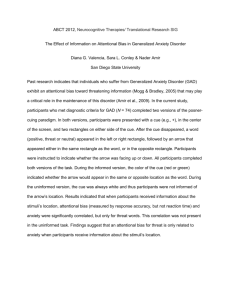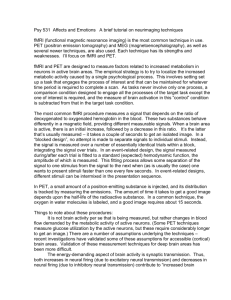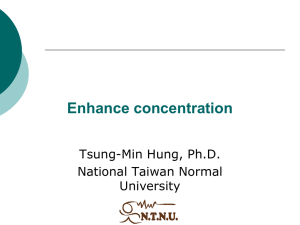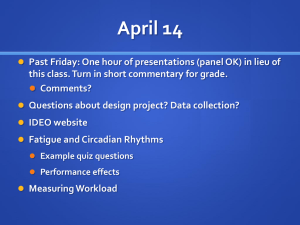Shipp Attention Notes
advertisement
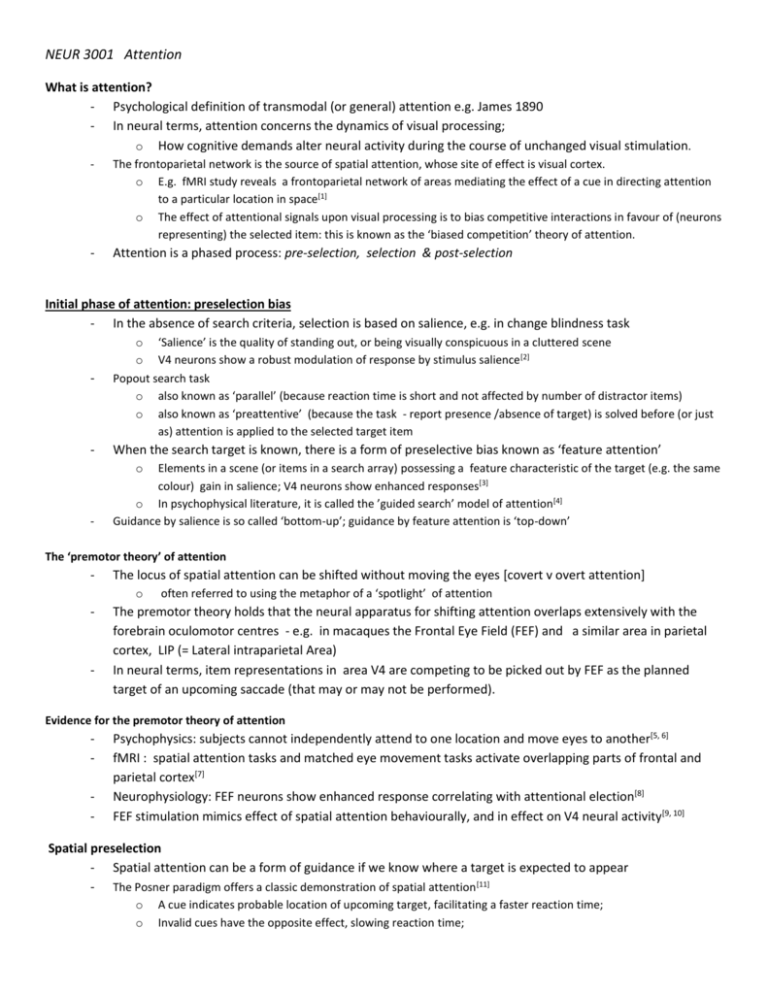
NEUR 3001 Attention What is attention? - Psychological definition of transmodal (or general) attention e.g. James 1890 - In neural terms, attention concerns the dynamics of visual processing; o How cognitive demands alter neural activity during the course of unchanged visual stimulation. - The frontoparietal network is the source of spatial attention, whose site of effect is visual cortex. o E.g. fMRI study reveals a frontoparietal network of areas mediating the effect of a cue in directing attention to a particular location in space[1] o The effect of attentional signals upon visual processing is to bias competitive interactions in favour of (neurons representing) the selected item: this is known as the ‘biased competition’ theory of attention. - Attention is a phased process: pre-selection, selection & post-selection Initial phase of attention: preselection bias - In the absence of search criteria, selection is based on salience, e.g. in change blindness task o o ‘Salience’ is the quality of standing out, or being visually conspicuous in a cluttered scene V4 neurons show a robust modulation of response by stimulus salience[2] - Popout search task o also known as ‘parallel’ (because reaction time is short and not affected by number of distractor items) o also known as ‘preattentive’ (because the task - report presence /absence of target) is solved before (or just as) attention is applied to the selected target item - When the search target is known, there is a form of preselective bias known as ‘feature attention’ o - Elements in a scene (or items in a search array) possessing a feature characteristic of the target (e.g. the same colour) gain in salience; V4 neurons show enhanced responses[3] o In psychophysical literature, it is called the ’guided search’ model of attention[4] Guidance by salience is so called ‘bottom-up’; guidance by feature attention is ‘top-down’ The ‘premotor theory’ of attention - The locus of spatial attention can be shifted without moving the eyes [covert v overt attention] - The premotor theory holds that the neural apparatus for shifting attention overlaps extensively with the forebrain oculomotor centres - e.g. in macaques the Frontal Eye Field (FEF) and a similar area in parietal cortex, LIP (= Lateral intraparietal Area) In neural terms, item representations in area V4 are competing to be picked out by FEF as the planned target of an upcoming saccade (that may or may not be performed). o - often referred to using the metaphor of a ‘spotlight’ of attention Evidence for the premotor theory of attention - Psychophysics: subjects cannot independently attend to one location and move eyes to another[5, 6] fMRI : spatial attention tasks and matched eye movement tasks activate overlapping parts of frontal and parietal cortex[7] Neurophysiology: FEF neurons show enhanced response correlating with attentional election[8] FEF stimulation mimics effect of spatial attention behaviourally, and in effect on V4 neural activity[9, 10] Spatial preselection - Spatial attention can be a form of guidance if we know where a target is expected to appear - The Posner paradigm offers a classic demonstration of spatial attention [11] o o A cue indicates probable location of upcoming target, facilitating a faster reaction time; Invalid cues have the opposite effect, slowing reaction time; o - Cues can be of a exogenous kind (occurring at the target locus) or of an endogenous kind (a symbolic cue occurring elsewhere, e.g. at fixation); o Exogenous/bottom-up cueing is a short-term, automatic or ‘reflexive’ effect: the cue does not have to be statistically reliable. ‘Inhibition of return’ refers to a an increased reaction time to a target presented at a longer period after an exogenous cue. o Endogenous/symbolic/top-down cueing is a ‘cognitive’ effect: the cue must be reliable (e.g. 80% valid). o The terms ‘bottom-up’ (BU) and ‘top-down’ (TD) are often used rather loosely; strictly, TD& BU refer to the source of the bias in attentional selection (i.e. they do not refer to a direction of communication in a hierarchy of brain areas) o An exogenous cue can be considered to engender top-down attention, with a longer timecourse, if the cue is reliable, and its meaning is understood by ; The cue location is ‘stored’ in the form of persistent elevated activity of FEF neurons initially excited by the cue [12] Attentional selection Events taking place within the fronto-parietal network may be regarded as the ‘selection’ phase of attention: o These events may be influenced by spatial cues, by pre-existing knowledge of how to interpret symbolic cues, or by feature specific pre-selective bias, or by any combination of these factors; o Selection by the fronto-parietal network is essentially spatial in character; oculomotor (attention shifting) fronto-parietal neurons have little inherent feature specificity; o Since there are recurrent interactions between the fronto-parietal network and the visual areas of the ventral pathway, there is no absolutely strict subdivision into temporally separate pre-selection, selection, & postselection phases: the neural mechanisms sustaining each phase can overlap. Post-selection phase: the effects of attentional selection (object attention) There is an enhanced response to the selected item, especially when it is accompanied by rival distractor items, such as in a search task [3]. o The enhanced response to salient items may also be attenuated, if the salient item is not the selected one [2], as may be the case if there are overriding top-down priorities; Attentional enhancement spreads to the representations of all the features of the attended object, even if they are irrelevant to the original selection criteria; this is known as ‘object attention’. o Evidence for object attention from fMRI[13, 14] & neurophysiology[15] The post-selection enhancement of the constellation of the selected object’s features (i.e. ‘object attention’) is also referred to as ‘integrated competition’: [ See #20, #21 & #31 in the general reading list]. Recordings of local field potential (LFP) show enhanced synchronization, both locally within a visual area (e.g. V4), and between areas: o e.g. selective synchronization between V4, and V1 neurons activated by attended v non-attended item[16]; o e.g. enhanced synchronization between subsets of FEF and V4 neurons whose RFs overlap the target [17] If there are multiple stimuli within a neuron’s receptive field, the receptive field appears to ‘collapse’ about the attended item; this may enhance the response if the item matches the neuron’s feature selectivity, or suppress the response if it does not [18] o ‘Collapsing’ or ‘shrinking’ RFs are only a convenient metaphor to describe what happens; the actual effects are well predicted by a ‘response normalization’ model of attention [19] The exact effect of selection depends on the nature of the particular task; attention is very flexible and can be deployed in numerous different ways… Reading List[20-22] [23-35] [36] - http://psychclassics.yorku.ca/James/Principles/prin11.htm for a reproduction of William James’ chapter on attention from ‘The Principles of Psychology’ 1890 Specific Sources 1. The neural mechanisms of top-down attentional control. Hopfinger et al., Nature Neuroscience 3: 284-291 (2000). 2. Influence and limitations of popout in the selection of salient visual stimuli by area V4 neurons. Burrows & Moore, Journal of Neuroscience 29: 15169-15177 (2009). 3. Parallel and serial neural mechanisms for visual search in macaque area V4. Bichot et al., Science 308: 529-534 (2005). 4. Guided Search 2.0: A revised model of visual search. Wolfe, Psychonomic Bulletin & Review 1: 202-238 (1994). 5. The role of attention in the programming of saccades. Kowler et al., Vision Research 35: 1897-1916. (1995). 6. Orienting of attention and eye movements. Sheliga et al., Experimental Brain Research 98: 507-522 (1994). 7. A common network of functional areas for attention and eye movements. Corbetta et al., Neuron 21: 761-773 (1998). 8. Neuronal basis of covert spatial attention in the frontal eye field. Thompson et al., Journal of Neuroscience 25: 9479-9487 (2005). 9. Microstimulation of the frontal eye field and its effects on covert spatial attention. Moore & Fallah, Journal of Neurophysiology 17: 17 (2004). 10. Changes in visual receptive fields with microstimulation of frontal cortex. Armstrong et al., Neuron 50: 791-798 (2006). 11. Orienting of attention. Posner, Quarterly Journal of Experimental Psychology 32: 3-25 (1980). 12. Selection and maintenance of spatial information by frontal eye field neurons. Armstrong et al., Journal of Neuroscience 29: 15621-15629 (2009). 13. fMRI evidence for objects as the units of attentional selection. O'Craven et al., Nature 401: 584-587 (1999). 14. Mechanisms of feature- and space-based attention: response modulation and baseline increases. McMains et al., Journal of Neurophysiology 98: 2110-2121 (2007). 15. Attention to the Color of a Moving Stimulus Modulates Motion-Signal Processing in Macaque Area MT: Evidence for a Unified Attentional System. Katzner et al., Frontiers in Systems Neuroscience 3: 12 (2009). 16. Attentional stimulus selection through selective synchronization between monkey visual areas. Bosman et al., Neuron 75: 875-888 (2012). 17. High-frequency, long-range coupling between prefrontal and visual cortex during attention. Gregoriou et al., Science 324: 1207-1210 (2009). 18. Selective attention gates visual processing in the extrastriate cortex. Moran & Desimone, Science 229: 782-784 (1985). 19. Attentional modulation of MT neurons with single or multiple stimuli in their receptive fields. Lee & Maunsell, Journal of Neuroscience 30: 3058-3066 (2010). General Reading (if in doubt where to start, work in reverse chronological order) 20. Competitive brain activity in visual attention. Duncan et al., Current Opinion in Neurobiology 7: 255-261 (1997). 21. Visual attention mediated by biased competition in extrastriate visual cortex. Desimone, Philosophical Transactions of the Royal Society of London, B 353: 1245-1255 (1998). 22. Feature binding, attention and object perception. Treisman, Philosophical Transactions of the Royal Society of London, B 353: 1295-1306 (1998). 23. Attentional capture and inattentional blindness. Simons, Trends in Cognitive Sciences 4: 147-155 (2000). 24. Visuomotor origins of covert spatial attention. Moore et al., Neuron 40: 671-683 (2003). 25. The brain circuitry of attention. Shipp, Trends in Cognitive Sciences 8: 223-230. (2004). 26. Feature-based attention in visual cortex. Maunsell & Treue, Trends in Neurosciences 29: 317-322 (2006). 27. The neurobiology of visual attention: finding sources. Moore, Current Opinion in Neurobiology 16: 159-165 (2006). 28. Selective visual attention and perceptual coherence. Serences & Yantis, Trends in Cognitive Sciences 10: 38-45 (2006). 29. Attention and consciousness: two distinct brain processes. Koch & Tsuchiya, Trends in Cognitive Sciences 11: 16-22 (2007). 30. Top-down and bottom-up mechanisms in biasing competition in the human brain. Beck & Kastner, Vision Research 49: 1154-1165 (2009). 31. Top-down control of visual attention. Noudoost et al., Current Opinion in Neurobiology 20: 183-190 (2010). 32. The neural basis of visual attention. Bisley, Journal of Physiology 589: 49-57 (2011). 33. The role of the lateral intraparietal area in orienting attention and its implications for visual search. Bisley et al., European Journal of Neuroscience 33: 1982-1990 (2011). 34. Mechanisms of top-down attention. Baluch & Itti, Trends in Neurosciences 34: 210-224 (2011). 35. Cortical circuits for the control of attention. Miller & Buschman, Current Opinion in Neurobiology 23: 216-222 (2013). 36. The neural basis of attentional control in visual search. Eimer, Trends in Cognitive Sciences (2014).

